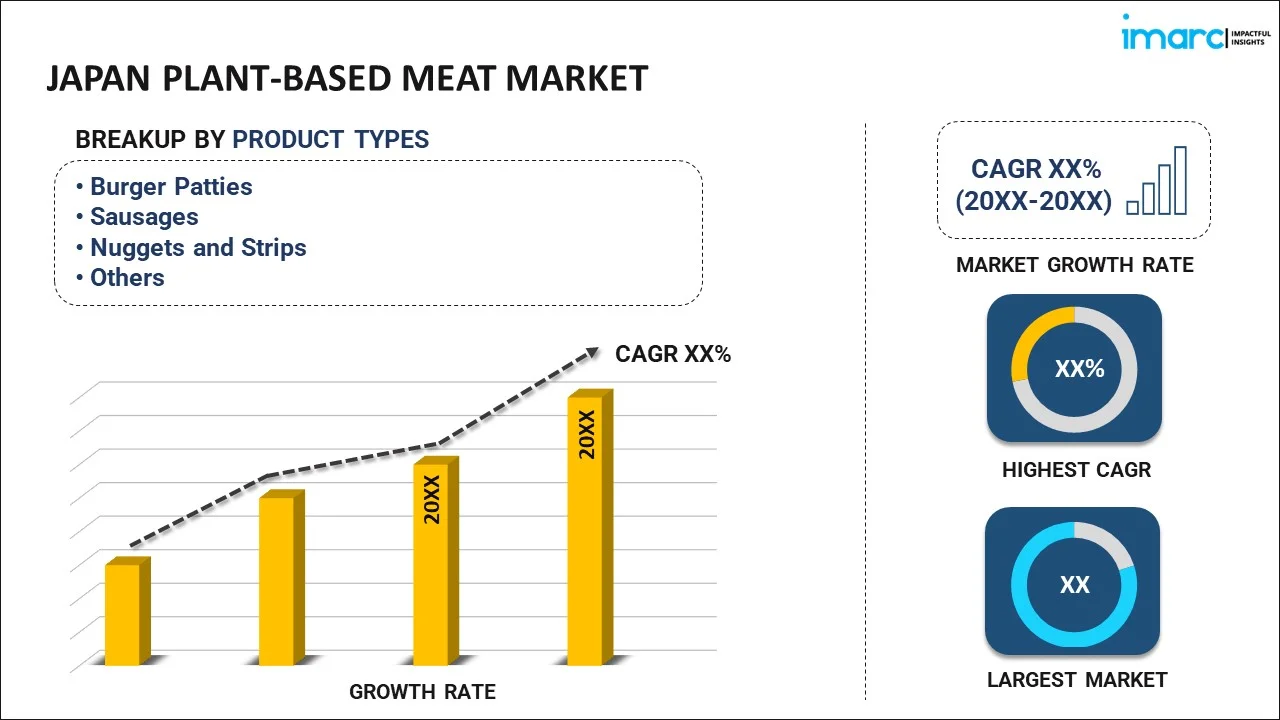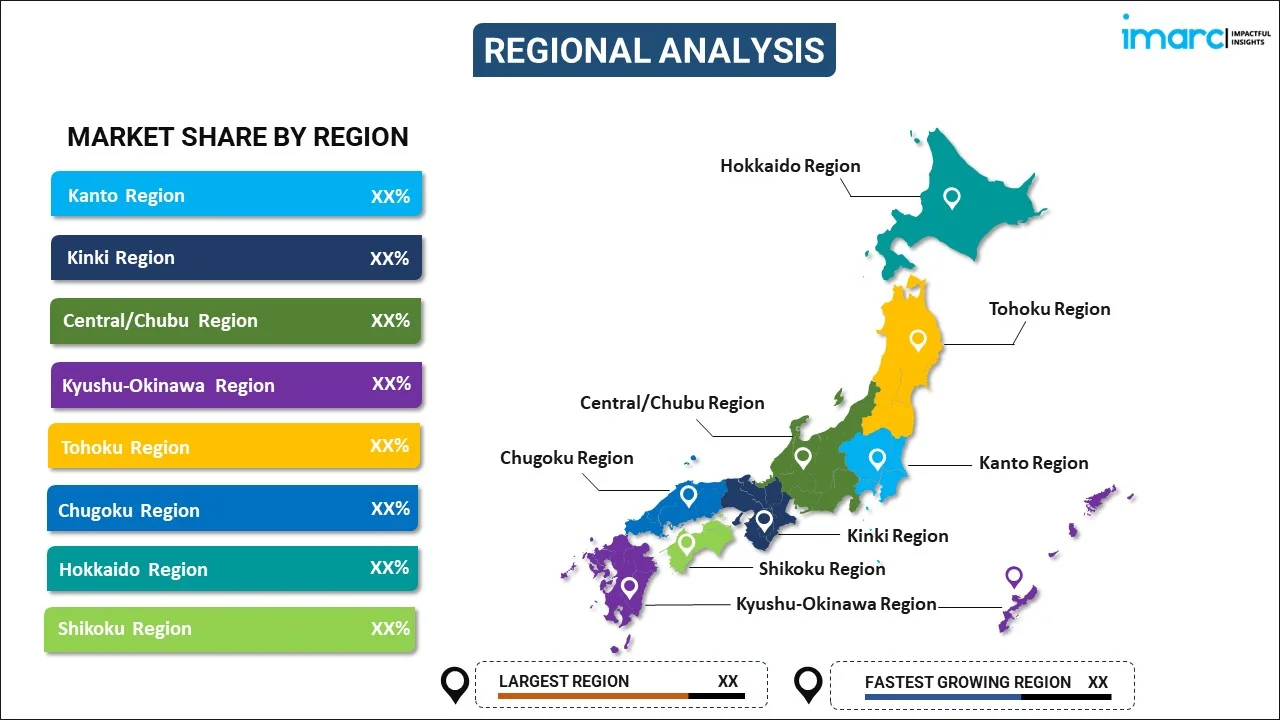
Japan Plant-Based Meat Market Report by Product Type (Burger Patties, Sausages, Nuggets and Strips, Ground Meat, Meatballs, and Others), Source (Soy, Wheat, Peas, and Others), Meat Type (Chicken, Beef, Pork, and Others), Distribution Channel (Restaurant and Catering Industry, Supermarkets and Hypermarkets, Convenience and Specialty Store, Online Retail), and Region 2025-2033
Market Overview:
The Japan plant-based meat market size reached USD 980.2 Million in 2024. Looking forward, IMARC Group expects the market to reach USD 5,448 Million by 2033, exhibiting a growth rate (CAGR) of 21% during 2025-2033. The rising health consciousness among the masses, favorable government initiatives, increasing inclination among the masses to adopt vegetarian or vegan diets and rising expenditure capacities of consumers represent some of the key factors driving the market.
|
Report Attribute
|
Key Statistics
|
|---|---|
|
Base Year
|
2024 |
|
Forecast Years
|
2025-2033
|
|
Historical Years
|
2019-2024
|
| Market Size in 2024 | USD 980.2 Million |
| Market Forecast in 2033 | USD 5,448 Million |
| Market Growth Rate (2025-2033) | 21% |
Plant-based meat refers to food products that are designed to replicate the taste, texture, and appearance of traditional animal-based meats, such as beef, chicken, pork, or seafood. These products are typically made using a combination of plant proteins, such as soy, wheat, peas, or mushrooms, along with various other ingredients to create a meat-like texture and flavor. Plant-based meat also consists of other ingredients like oils, spices, and binders that are further processed with additives and coloring agents to attain flavor and texture, similar to animal meat. As compared to traditional animal-based meats, plant-based meat is lower in saturated fat, cholesterol, and calories and may offer health benefits such as reduced risk of heart disease and certain cancers.
Japan Plant-Based Meat Market Trends:
The rising health consciousness among the masses is one of the key factors creating a positive outlook for the market. Plant-based meat offers various health benefits as they are often lower in saturated fats and cholesterol while offering higher protein content. In line with this, the increasing inclination among the masses to adopt vegetarian or vegan diets is facilitating the demand for plant-based meat products as a substitute for traditional meat. Moreover, Japan has been gradually recognizing the environmental impact of animal agriculture, including greenhouse gas emissions and land use, which is favoring the market growth. Apart from this, growing partnerships between local food companies, restaurants, and international plant-based meat producers to introduce new products and increase consumer awareness is providing a considerable boost to the market growth. Furthermore, the growing inclination toward veganism coupled with the rising concerns of animal welfare and protection is contributing to the market growth. Additionally, the introduction of several awareness programs by various animal welfare organizations for reducing excessive animal killing for meat consumption is propelling the market growth. Besides this, the widespread product adoption among individuals who follow vegetarian or vegan diets due to cultural, religious, or personal beliefs is positively influencing the market growth. Other factors, including rising environmental consciousness, increasing expenditure capacities of consumers, rapid technological advancements, and high-profile celebrities and athletes endorsing plant-based diets and plant-based meat products, are supporting the market growth.
Japan Plant-Based Meat Market Segmentation:
IMARC Group provides an analysis of the key trends in each segment of the Japan plant-based meat market report, along with forecasts at the country level for 2025-2033. Our report has categorized the market based on product type, source, meat type, and distribution channel.
Product Type Insights:

- Burger Patties
- Sausages
- Nuggets and Strips
- Ground Meat
- Meatballs
- Others
The report has provided a detailed breakup and analysis of the market based on the product type. This includes burger patties, sausages, nuggets and strips, ground meat, meatballs, and others.
Source Insights:
- Soy
- Wheat
- Peas
- Others
A detailed breakup and analysis of the market based on the source has also been provided in the report. This includes soy, wheat, peas, and others.
Meat Type Insights:
- Chicken
- Beef
- Pork
- Others
A detailed breakup and analysis of the market based on the meat type has also been provided in the report. This includes chicken, beef, pork, and others.
Distribution Channel Insights:
- Restaurant and Catering Industry
- Supermarkets and Hypermarkets
- Convenience and Specialty Store
- Online Retail
A detailed breakup and analysis of the market based on the distribution channel has also been provided in the report. This includes restaurant and catering industry, supermarkets and hypermarkets, convenience and specialty store, and online retail.
Regional Insights:

- Kanto Region
- Kinki Region
- Central/Chubu Region
- Kyushu-Okinawa Region
- Tohoku Region
- Chugoku Region
- Hokkaido Region
- Shikoku Region
The report has also provided a comprehensive analysis of all the major regional markets, which include Kanto Region, Kinki Region, Central/Chubu Region, Kyushu-Okinawa Region, Tohoku Region, Chugoku Region, Hokkaido Region, and Shikoku Region.
Competitive Landscape:
The report has also provided a comprehensive analysis of the competitive landscape in the market. Competitive analysis such as market structure, key player positioning, top winning strategies, competitive dashboard, and company evaluation quadrant has been covered in the report. Also, detailed profiles of all major companies have been provided.
Japan Plant-Based Meat Market Report Coverage:
| Report Features | Details |
|---|---|
| Base Year of the Analysis | 2024 |
| Historical Period | 2019-2024 |
| Forecast Period | 2025-2033 |
| Units | Million USD |
| Scope of the Report | Exploration of Historical and Forecast Trends, Industry Catalysts and Challenges, Segment-Wise Historical and Predictive Market Assessment:
|
| Product Types Covered | Burger Patties, Sausages, Nuggets and Strips, Ground Meat, Meatballs, Others |
| Sources Covered | Soy, Wheat, Peas, Others |
| Meat Types Covered | Chicken, Beef, Pork, Others |
| Distribution Channels Covered | Restaurant and Catering Industry, Supermarkets and Hypermarkets, Convenience and Specialty Store, Online Retail |
| Regions Covered | Kanto Region, Kinki Region, Central/Chubu Region, Kyushu-Okinawa Region, Tohoku Region, Chugoku Region, Hokkaido Region, Shikoku Region |
| Customization Scope | 10% Free Customization |
| Post-Sale Analyst Support | 10-12 Weeks |
| Delivery Format | PDF and Excel through Email (We can also provide the editable version of the report in PPT/Word format on special request) |
Key Questions Answered in This Report:
- How has the Japan plant-based meat market performed so far and how will it perform in the coming years?
- What has been the impact of COVID-19 on the Japan plant-based meat market?
- What is the breakup of the Japan plant-based meat market on the basis of product type?
- What is the breakup of the Japan plant-based meat market on the basis of source?
- What is the breakup of the Japan plant-based meat market on the basis of meat type?
- What is the breakup of the Japan plant-based meat market on the basis of distribution channel?
- What are the various stages in the value chain of the Japan plant-based meat market?
- What are the key driving factors and challenges in the Japan plant-based meat market?
- What is the structure of the Japan plant-based meat market and who are the key players?
- What is the degree of competition in the Japan plant-based meat market?
Key Benefits for Stakeholders:
- IMARC’s report offers a comprehensive quantitative analysis of various market segments, historical and current market trends, market forecasts, and dynamics of the Japan plant-based meat market from 2019-2033.
- The research study provides the latest information on the market drivers, challenges, and opportunities in the Japan plant-based meat market.
- Porter's five forces analysis assist stakeholders in assessing the impact of new entrants, competitive rivalry, supplier power, buyer power, and the threat of substitution. It helps stakeholders to analyze the level of competition within the Japan plant-based meat industry and its attractiveness.
- Competitive landscape allows stakeholders to understand their competitive environment and provides an insight into the current positions of key players in the market.
Need more help?
- Speak to our experienced analysts for insights on the current market scenarios.
- Include additional segments and countries to customize the report as per your requirement.
- Gain an unparalleled competitive advantage in your domain by understanding how to utilize the report and positively impacting your operations and revenue.
- For further assistance, please connect with our analysts.
 Inquire Before Buying
Inquire Before Buying
 Speak to an Analyst
Speak to an Analyst
 Request Brochure
Request Brochure
 Request Customization
Request Customization




.webp)




.webp)












